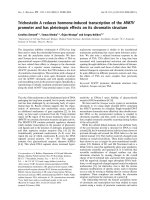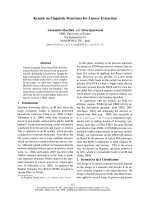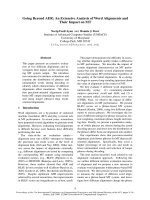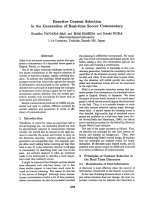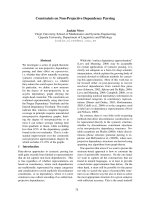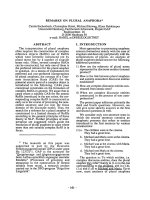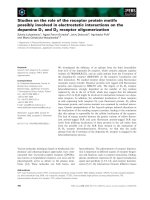báo cáo khoa học: " Commentary on Vorobjov et al., "Comparison of injection drug users who obtain syringes from pharmacies and syringe exchange programs in Tallinn, Estonia"" doc
Bạn đang xem bản rút gọn của tài liệu. Xem và tải ngay bản đầy đủ của tài liệu tại đây (179.88 KB, 2 trang )
BioMed Central
Page 1 of 2
(page number not for citation purposes)
Harm Reduction Journal
Open Access
Commentary
Commentary on Vorobjov et al., "Comparison of injection drug
users who obtain syringes from pharmacies and syringe exchange
programs in Tallinn, Estonia"
Daniel Werb
1,2
and Evan Wood*
1,2
Address:
1
British Columbia Centre for Excellence in HIV/AIDS, Vancouver, Canada and
2
School of Population and Public Health, University of
British Columbia, Vancouver, Canada
Email: Daniel Werb - ; Evan Wood* -
* Corresponding author
Abstract
Recent data suggest that globally, between 5% and 10% of all new HIV cases are the result of unsafe
injecting practices, and experts agree that reducing these practices is key to tackling the spread of
HIV. And yet, despite the overwhelming evidence that providing sterile syringes to injection drug
users (IDU) through syringe exchange programs (SEPs) or other means is an effective way of
reducing HIV transmission among high-risk subpopulations, IDU in most settings still do not have
access to sterile injecting equipment or if they do, access remains too restricted to effectively
reduce the risk of HIV transmission. Vorobjov and colleagues have presented in this journal an
interesting and timely study from Estonia comparing individuals who obtain syringes from SEPs and
those who obtain syringes from pharmacies. As the authors point out, Estonia faces an
unacceptably high HIV incidence rate of 50 new HIV cases per 100,000, this rate driven primarily
by injection drug use. As such, the authors argue that Estonia's SEP network does not have the
capacity to serve a growing IDU population at risk of transmitting HIV and pharmacy dispensation
of clean syringes may be one potential approach to decreasing syringe sharing among high-risk
injectors. It may be overly optimistic to consider the impact of higher threshold interventions such
as pharmacy-based SEPs, given that IDU populations that engage in HIV risk behaviours such as
syringe sharing are often hidden or hard to reach. Despite the need for a cautious approach,
however, the findings presented by Vorobjov et al. may chart one potential course towards a more
comprehensive societal response to reducing the health harms associated with injection drug use.
A global consensus has been reached regarding the pri-
mary role of syringe sharing in driving the HIV epidemic
among injection drug users (IDU), and there is growing
international recognition of the interventions required to
address this public health crisis. Recent data suggest that
globally, between 5% and 10% of all new HIV cases are
the result of unsafe injecting practices [1,2], and experts
agree that reducing these practices is key to tackling the
spread of HIV. Despite this scientific consensus, there still
exists a shortage of resources allocated towards the scale-
up of interventions to address the harms associated with
syringe sharing. For instance, while approximately 83% of
all countries reporting HIV-infection among IDU subpop-
ulations have at least one syringe exchange program
(SEP), certain regions such as Eastern Europe and the
former Soviet Union continue to report that 70% to 90%
Published: 27 November 2009
Harm Reduction Journal 2009, 6:33 doi:10.1186/1477-7517-6-33
Received: 22 July 2009
Accepted: 27 November 2009
This article is available from: />© 2009 Werb and Wood; licensee BioMed Central Ltd.
This is an Open Access article distributed under the terms of the Creative Commons Attribution License ( />),
which permits unrestricted use, distribution, and reproduction in any medium, provided the original work is properly cited.
Harm Reduction Journal 2009, 6:33 />Page 2 of 2
(page number not for citation purposes)
of all HIV infections are the result of injection drug use
[2]. This problem persists despite the fact that the World
Health Organization and a number of other multilateral
organizations and national public health authorities have
endorsed SEPs as a simple method of reducing the risks
for HIV transmission associated with syringe sharing [1].
And yet, despite the overwhelming evidence that provid-
ing sterile syringes to IDU through SEPs or other means is
an effective way of reducing HIV transmission among
high-risk subpopulations [3], IDU in most settings still do
not have access to sterile injecting equipment or if they
do, access remains too restricted to effectively reduce the
risk of HIV transmission [4].
This is of concern, particularly in light of the many inter-
ventions available to policymakers considering how best
to distribute sterile syringes to different IDU subpopula-
tions. For example, Riley and colleagues found that first-
time syringe exchange participants who acquired sterile
syringes from mobile sites (i.e., syringe exchange vans) in
Baltimore were more likely to be frequent injectors, sug-
gesting that these interventions may effectively target
highly dependent individuals [5]. Other researchers have
confirmed that, while IDU accessing SEPs often have
higher risk profiles for the transmission of HIV and other
blood-borne diseases, SEPs themselves are an efficient
means of reducing health risks among hard-to-reach, stig-
matized, and hidden populations [6,7].
Vorobjov and colleagues have presented in this journal an
interesting and timely study from Estonia comparing indi-
viduals who obtain syringes from SEPs and those who
obtain syringes from pharmacies [8]. As the authors point
out, Estonia faces an unacceptably high HIV incidence
rate of 50 new HIV cases per 100,000, this rate driven pri-
marily by injection drug use. As such, the authors argue
that Estonia's SEP network does not have the capacity to
serve a growing IDU population at risk of transmitting
HIV. Within this context, the study investigated whether
pharmacies that dispensed sterile injecting equipment
complement SEPs in serving the needs of Estonian IDU,
and whether differences exist between individuals that
primarily use SEPs compared with those that primarily
use pharmacies to acquire sterile injecting equipment.
In their analysis, Vorobjov and colleagues found that indi-
viduals who reported using pharmacies as their primary
source of sterile equipment exhibited lower risks of HIV
transmission than IDU who primarily used SEPs. Like
many studies of IDU, this study is limited by its cross-sec-
tional design and its use of non-random sampling. As
well, the possibility exists that the merging of users of
SEPs and pharmacies within the sample may have led to
unmeasured confounders. Nevertheless, it presents
important new data and highlights the potential of phar-
macies in playing an early preventive role in limiting the
risk trajectory of IDU, and it does so in a region that is
hard hit by an injection-fuelled HIV epidemic and is in
need of epidemiologic research. If, as the authors suggest,
IDU who visit pharmacies represent a subpopulation at
an earlier stage of their injecting careers, pharmacies could
play a key role in connecting IDU to treatment such as
methadone and preventive services prior to a transition to
riskier use of injection drugs [9]. If feasible, pharmacies
could also be potential locales for the provision of addic-
tion treatment, counseling, detoxification referral, or
social services. Further longitudinal research in this area is
therefore needed.
The limits of SEPs in servicing IDU are well-known [10].
As such, it may be overly optimistic to consider the impact
of higher threshold interventions such as pharmacy-based
SEPs. Despite the need for a cautious approach, however,
the findings presented by Vorobjov et al. may chart one
potential course towards a more comprehensive societal
response to reducing the health harms associated with
injection drug use, and could also hold lessons for policy-
makers and health authorities in other settings that may
be struggling to reduce the transmission of HIV among
hard to reach IDU populations.
References
1. World Health O: Harm reduction approaches to injecting drug
use. Geneva: World Health Organization; 2006.
2. Aceijas C, Hickman M, Donoghoe M, Burrows D, Stuikyte R: Access
and coverage of needle and syringe programmes (NSP) in
Central and Eastern Europe and Central Asia. Addiction 2007,
102:1244-1250.
3. Cooney A, Wodak A: Effectiveness of sterile needle and syringe
programming in reducing HIV/AIDS among injecting drug
users. 2004.
4. Wolfe D, Malinowska-Sempruch K: Illicit drug policies and the
global HIV epidemic: Effects of UN and national government
approaches. New York: Open Society Institute; 2004:1.
5. Riley ED, Mahboobeh S, Strathdee SA, Marx MA, Huettner S, Beilen-
son P, Vlahov D: Comparing new participants of a mobile ver-
sus a pharmacy-based needle exchange program. JAIDS 2000,
24:57-61.
6. Broadhead RS, Kerr TH, Grund J-pC, Altice FL: Safer Injection
Facilities in North America: their Place in Public Policy and
Health Initiatives. Journal of Drug Issues 2002, 32:329.
7. Jurgens R, Kerr T, Lines R, Stover H, Laticevschi D, Nelles J: Prison
needle exchange: Lessons from a comprehensive review of
international evidence and expertise. Toronto: Canadian HIV/
AIDS Legal Network; 2006:1.
8. Vorobjov S, Uuskula A, Abel-Ollo K, Talu A, Ruutel K, Des Jarlais D:
Comparison of injecting drug users who obtain syringes
from pharmacies and syringe exchange programs in Tallinn,
Estonia. Harm Reduction Journal 2009:6.
9. World Health Organization UNOoDaCU: Substitution mainte-
nance therapy in the management of opioid dependence and
HIV/AIDS prevention: position paper. 2004.
10. Jurgens R, Ball A, Verster A: Interventions to reduce HIV trans-
mission related to injecting drug use in prison. Lancet Infect Dis
2009, 9:57-66.

